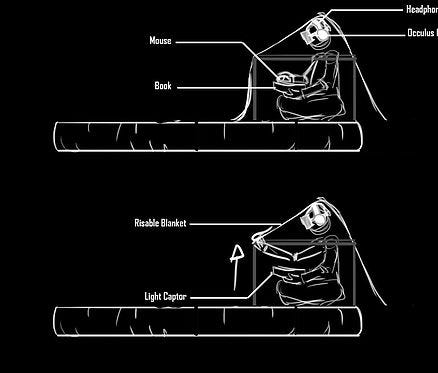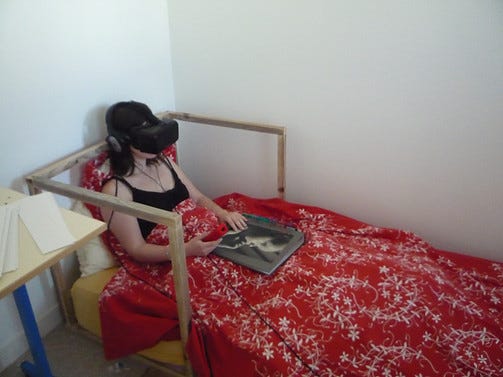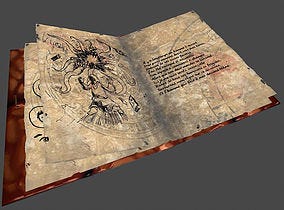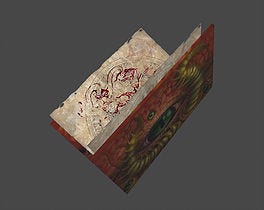Trending
Opinion: How will Project 2025 impact game developers?
The Heritage Foundation's manifesto for the possible next administration could do great harm to many, including large portions of the game development community.
"This VR game places you back in your childhood, when you were trying to read under your duvet with a flashlight. As you progress through the pages, you will be plunged into a frightening world!"

The 2016 Game Developer's Conference will feature an exhibition called alt.ctrl.GDC dedicated to games that use alternative control schemes and interactions. Gamasutra will be talking to the developers of each of the games that have been selected for the showcase. You can find all of the interviews here.
Little Book, a first year project by students at École Nationale du Jeu et des Médias Interactifs Numériques’ (Enjmin), has been selected for the Alt.CTRL.GDC showcase. It aims to use VR to recreate the common childhood experience of terrifying yourself by reading a scary book under the covers at night. The game involves an Oculus Rift and an Arduino-equipped book...but a blanket is also a vital part of the interactivity.
Gamasutra spoke to the designer of the game to get more info about how it was made.
My name is Amélia Lopes and I was the game designer on Little Book. I imagined and wrote the content of the book, the progress and dialogues. Chloé Duretti was the level designer and she did the puzzles, Vincent Swaenepoel was the programmer, Benjamin Rigotti worked on graphic direction and to finish, Adrien Maljournal was the sound designer..
To sum up : easy and intuitive. When you play Little Book, you have a book on your knees, a blanket on your head, headphones, a mouse and a VR headset. What’s great with our game is that you actually see this same book and blanket in game using the VR headset. That’s why even if you never played a VR game before--using these controllers is easy, because you're physically handling in real life what you see in game.
I started by making sound design studies. At this time, I did internships in several video games studios. After that, I did game design studies and I’m currently finishing this year my master degree. I worked on three student projects as a game designer, and also did a dozen of game jams as a game designer and/or sound designer.
We made the game with Unity. For the book, we used the Arduino SDK and uniduino. Regarding VR, we used Oculus Utilities for Unity and finally we used the sound engine Audiokinetic Wwise with the AstoundSoundRTI plugin for binaural audio.
Regarding electronics, we used an Arduino Mega 2560 Card, 11 potentiometers linked to the pages, a light sensor to determine if the blanket is up or down. For the structure, we simply used a binder because we needed something strong enough to handle installations, traveling, and several game sessions. We planned something that could resist over the time. We also had to use thick pages, both for usability and turning the potentiometers. We printed some pieces with a 3D printer to hold pages, and to finish we used some cardboard to protect the electronic elements.
Finally, to make the book ornate we used leather, glass beads, paint, Sculpey, nail polish and Miliput putty



The game was made in three months.
The original idea was from Benjamin Rigotti, the artist of Little Book. The initial idea was a pitch intended for the Asylum game jam edition 2014. However, it was too ambitious in such a short time. That's why we decided to take the opportunity of the end of our 1st year Master's degree project to realize it. At first, this game was thought to be played with conventional controllers. But our programmer Vincent had other plans for us; he was eager to combine electronics, real objects and VR. And so we naturally decided to make the book the main controller of our game.
For the main idea, as it was a pitch intended for a horror game. We had for references Lovecraft's novels, mostly his Necronomicon.
This book inspired us and we made research on the different fears. We focused on childhood ones to find our gameplay ideas and the Little Book was born!


Our main inspiration comes from Lovecraft works for the universe and the idea of the book. The Necronomicon for its content, as much for the stories as the illustrations.
Also, we had a great time watching Mister Babadook. We must admit we loved this movie.
Regarding videogaming references, we had in mind the Silent Hill Playable Teaser. It was a huge inspiration for us.
For the experience, the environment is very important for a great immersion. Thanks to our device, the player is, like, in his own bubble. Usually we have a bed for him. At the GDC, however, we were unable to bring it due to traveling restrictions. But we’ll have all the other elements. Our game is very immersive because the player is physically implied within the game. We think he will feel isolated from the noisy environment thanks to the sound and all our devices.



Our favorite horror movies never reveal from the beginning what’s threatening the hero. That’s why for us the most important point and the main idea of Little Book was suggestion. The player doesn’t see the monsters and even when they briefly appear, it’s too quick to know exactly what’s going on, and that’s what create the tension. As the player progresses in his reading, the room is slightly turning into what’s described in the book. We found the process of a familiar and reassuring environment moving to something very hostile to be very frightening.
Regarding the position of the player, we thought placing him in a bed was the best perspective point of view to make him feel like a child and enhance the immersion.
Also, another reason for this was that we knew about the motion sickness possibility with VR. That’s why we decided to keep the player in a static position, that is, the same way he sees himself virtually in game. He has only to move his head and his hands.
.jpg/?width=548&auto=webp&quality=80&disable=upscale)
In my opinion, one can notice that some devices like smartphones and tablets for instance, which were considered very new a few years ago, became today’s standards. Technology evolves quickly and gamers easily adapt to it.
Regarding VR, it’s for now too expensive for most of players, but they are interested in it and I’m pretty sure that as with mobile devices, it will become the next standard. That’s why some big companies like Steam and Samsung are now also developing it while there was only Oculus at the beginning.
Moreover, I’m particularly fond of NFC, and it’s also becoming trendy lately. Physical objects are designed to be connected virtually with games. I think we’ll see more and more of these “smart” objects as game controllers in the videogame industry.
Nowadays they are action figures or cards, so it’s very possible we’ll see in 5 or 10 years more different objects… like a book for example!
You May Also Like